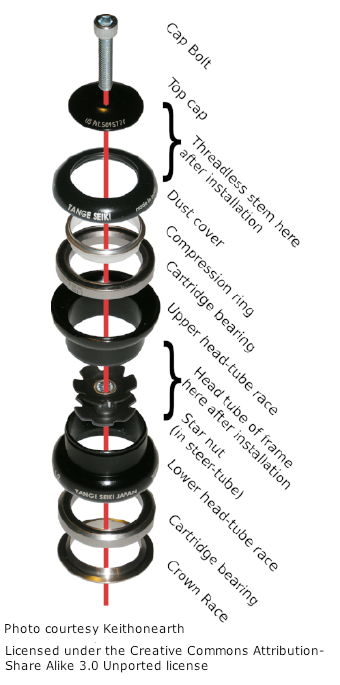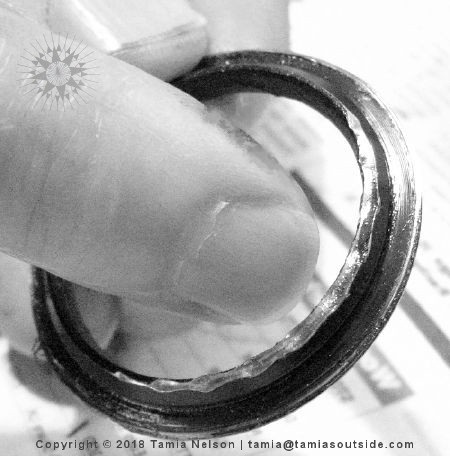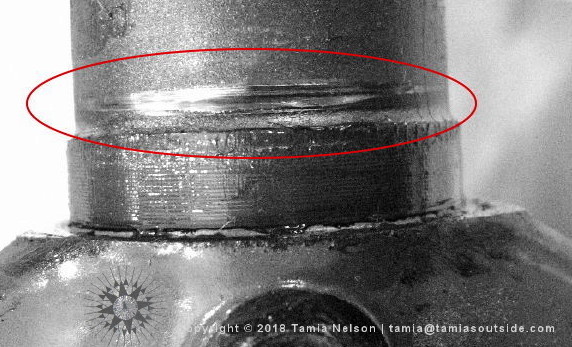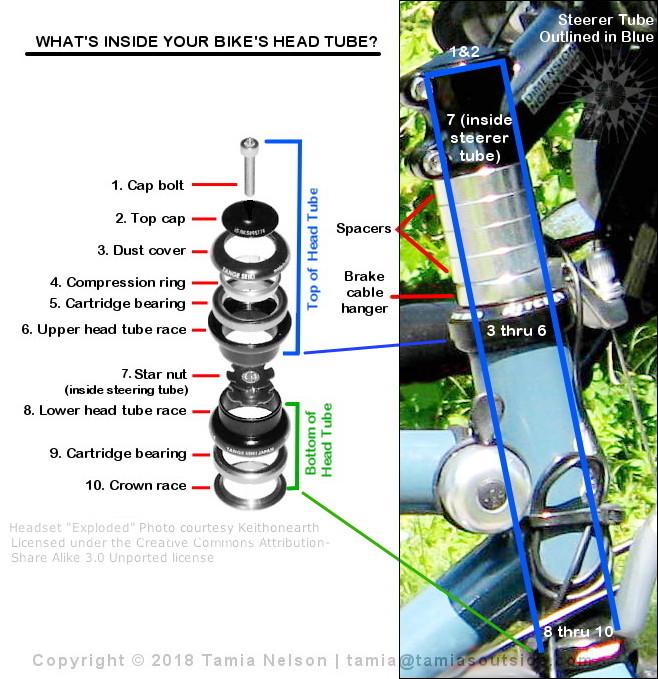Your bike’s headset is a critical component, for without it, you wouldn’t be able to steer. And it’s what keeps your front fork attached to your bike. So unless you’re keen to ride a unicycle, you’ll want to head off any problems.
______________________________
![]()
by Tamia Nelson | April 14, 2018
Whether you’re rolling out to ride the Paris-Robaix, or to do the weekly shopping, or for a circuit of the neighborhood, your bike’s headset better be in fine fettle. A lot rides on a bicycle’s headset. Most modern bikes are equipped with threadless headsets. This intricate assembly allows the front wheel to swing smoothly in its steering arc, and when paired with a suitable stem, it also keeps the fork securely attached to the frame, a matter of no little interest to the thoughtful cyclist.
So how does the headset accomplish its mission? Here’s an exploded view of a typical threadless headset, thanks to Keithonearth and Wikipedia:

The pictured headset uses cartridge bearings, but loose ball bearings in retainers are common, too. The upper and lower races—the channels through which the bearings roll—are press-fitted into the bike’s head tube, and if they’re improperly bedded, or if the grease washes away and you don’t replace it, the result can be “indexed steering.” This is something you don’t want.
A properly adjusted, well-lubricated headset will permit the front wheel to swing smoothly and easily from side to side, with no noticeable play. To check for excessive play, stand next to your bike, lock the front brake, then roc the bike forward and back. If the headset is very loose, you’ll hear (and feel) a distinct clunk, but this is an undemanding test. To catch the trouble before it reaches the clunking stage, just cup your hand around the fork crown and repeat the lock-and-rock process. Now you’ll be able to feel even the slightest click.
If you find excessive play, the remedy is easy: Take up the slack. But don’t overdo it. Too much preload on the headset bearings will shorten their life. “Indexed steering” is one likely result. It’s pretty easy to spot, though it’s a lagging indicator of headset trouble. By the time you notice it, the damage has been done. Still, it’s something you want to know. Just lift the front wheel off the ground and swing the bars from side to side. Smooth and easy? Then you’re good to go. But if the wheel moves from one apparently preset position to the next (that’s where the “indexed” comes in), you’re overdue for a new headset.
Here’s a worst-case scenario for your consideration: Farwell’s stock-build Surly Long Haul Trucker arrived with a poorly bedded headset. Unfortunately, it passed all the quick-and-dirty tests. The wheel turned easily, and there was no obvious indexing. It did seem a little hard to adjust the play, however. It was either too lose or too tight. But Farwell was in a hurry to get his new bike on the road, and he ignored the warning signs, settling for a “close enough” adjustment. This was a bad idea. The problem got worse during the first few hundred miles, and when Farwell finally acknowledged that something was seriously wrong, here’s what he found on the bike’s crown race:

Not a pretty sight, is it? The scalloped edge of the crown race exhibits a bad case of the damage commonly (if inaccurately) known as brinelling. The steerer tube was scoured, as well:

It was a terminal case. The headset was ruined beyond repair. The only cure? Fitting a new headset, which is what Farwell did. A hint: It’s not a job for the faint of heart.
The takeaway message? Check your headset often, and if perfect adjustment—neither too lose nor too tight—eludes you, don’t settle for good enough. Find out what’s wrong, and then put it right. Or have an experienced bicycle mechanic do the job for you. That’s probably the wisest course, in fact, since problems that can’t be resolved with a simple adjustment or lubrication often require replacing the headset, and that requires either specialist tools or a highly developed knack for improvisation. It’s not really a job for a rank beginner.
In other words, use your head. Keep your headset properly adjusted and lubricated. And when trouble surfaces, have it seen to without delay. That’s the only way to head off headset problems.


